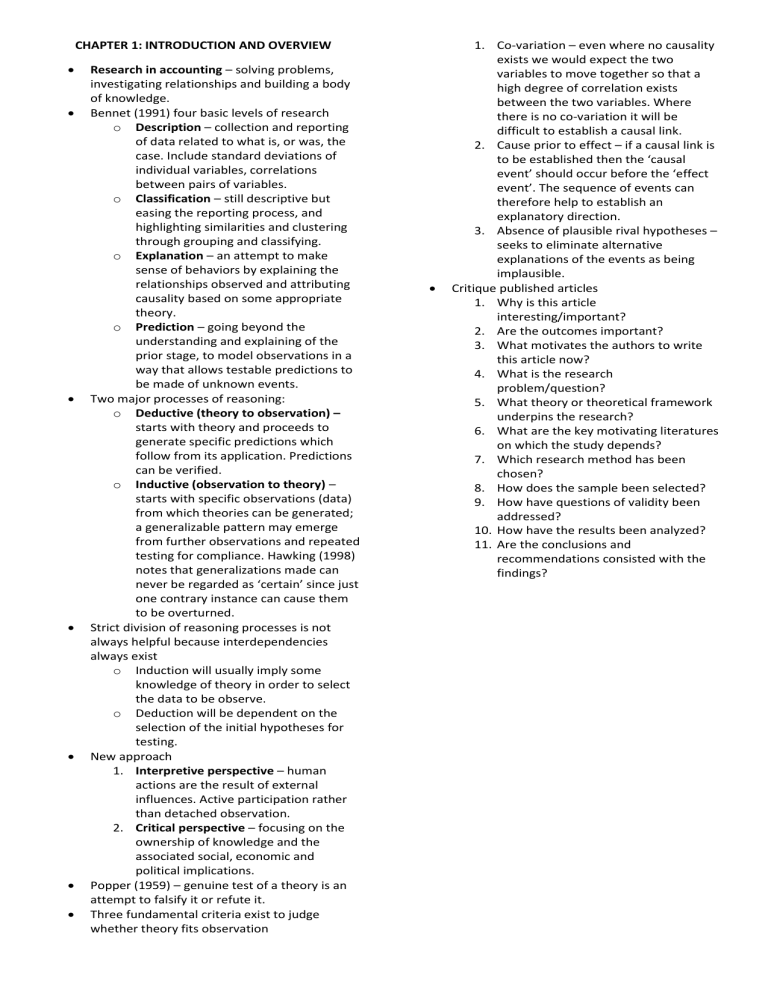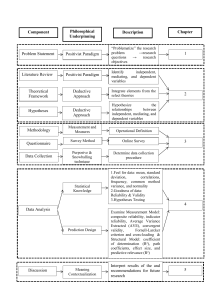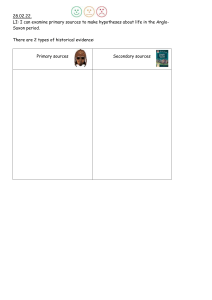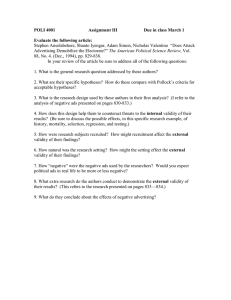
CHAPTER 1: INTRODUCTION AND OVERVIEW Research in accounting – solving problems, investigating relationships and building a body of knowledge. Bennet (1991) four basic levels of research o Description – collection and reporting of data related to what is, or was, the case. Include standard deviations of individual variables, correlations between pairs of variables. o Classification – still descriptive but easing the reporting process, and highlighting similarities and clustering through grouping and classifying. o Explanation – an attempt to make sense of behaviors by explaining the relationships observed and attributing causality based on some appropriate theory. o Prediction – going beyond the understanding and explaining of the prior stage, to model observations in a way that allows testable predictions to be made of unknown events. Two major processes of reasoning: o Deductive (theory to observation) – starts with theory and proceeds to generate specific predictions which follow from its application. Predictions can be verified. o Inductive (observation to theory) – starts with specific observations (data) from which theories can be generated; a generalizable pattern may emerge from further observations and repeated testing for compliance. Hawking (1998) notes that generalizations made can never be regarded as ‘certain’ since just one contrary instance can cause them to be overturned. Strict division of reasoning processes is not always helpful because interdependencies always exist o Induction will usually imply some knowledge of theory in order to select the data to be observe. o Deduction will be dependent on the selection of the initial hypotheses for testing. New approach 1. Interpretive perspective – human actions are the result of external influences. Active participation rather than detached observation. 2. Critical perspective – focusing on the ownership of knowledge and the associated social, economic and political implications. Popper (1959) – genuine test of a theory is an attempt to falsify it or refute it. Three fundamental criteria exist to judge whether theory fits observation 1. Co-variation – even where no causality exists we would expect the two variables to move together so that a high degree of correlation exists between the two variables. Where there is no co-variation it will be difficult to establish a causal link. 2. Cause prior to effect – if a causal link is to be established then the ‘causal event’ should occur before the ‘effect event’. The sequence of events can therefore help to establish an explanatory direction. 3. Absence of plausible rival hypotheses – seeks to eliminate alternative explanations of the events as being implausible. Critique published articles 1. Why is this article interesting/important? 2. Are the outcomes important? 3. What motivates the authors to write this article now? 4. What is the research problem/question? 5. What theory or theoretical framework underpins the research? 6. What are the key motivating literatures on which the study depends? 7. Which research method has been chosen? 8. How does the sample been selected? 9. How have questions of validity been addressed? 10. How have the results been analyzed? 11. Are the conclusions and recommendations consisted with the findings? CHAPTER 2: DEVELOPING THE RESEARCH IDEA Research sequence 1. Identify broad area 2. Select topic 3. Decide approach 4. Formulate plan 5. Collect information 6. Analyze data 7. Present findings The positivist approach 1. Problem 2. Literature review 3. Hypothesis development 4. Method 5. Results Alternative research methods Archival research Hypothesis testing using Laboratory standard experiments instruments/method/controls Survey method Quantitative data Deductive positivism Action research Quasi-research methods Field-based surveys/interviews Field research Subjective accounts ‘inside’ situations No a priori hypotheses Qualitative data Ethnographic method Research proposal elements o Title o Abstract o Issues o Objectives o Literature o Method o Benefits Basic conceptual scheme – provides a powerful tool for the examination of causal relationship in a positivist environment. Dependent variables – one or more outcome variables whose value may be influenced by a number (independent) explanatory factors. CHAPTER 3: THEORY, LITERATURE AND HYPOTHESES Three characteristics of accounting research o Theory o Reliability o Validity Expanded o Good theory o Reliability o Construct validity o Internal validity o External validity Theory – network of hypotheses or an allembracing notion that underpins one or more hypotheses Hypotheses – supposed relationships, possibly causal links, between two or more concepts or variables. A hypothesis should be testable, but it may not be directly so if it comprises a number of abstract concepts. Concepts – abstract ideas, not directly observable or measurable which must first be operationalized in some way to provide measurable indicators. Either by identifying a variable that is an adequate substitute for the concept or by developing a construct to provide a new measure of the concept. Constructs – indirect measures of concepts usually generated in the form of multi-item questions. The sum of a set of valid and reliable responses to the construct provides a measure of the concept. Variables – observable items which can assume different values. Values can be measured either directly or indirectly through the use of proxy (substitute) variables. o Independent – explanatory o Dependent – are explained by the independent variables o Moderating – have a conditional influence o Intervening – with an influence, potentially spurious, that needs to be controlled Reliability – establishes the consistency of a research instrument in that the results it achieves should be similar in similar circumstances. Validity – measures the degree to which our research achieves what it sets out to do. With internal validity – able to eliminate rival hypotheses with confidence because we can specify causal relationships; we know what is causing what because we are controlling for all other influential factors. No external validity – they cannot be generalized to the ‘real world’ because they only apply in the laboratory. Fundamental trade-off: we may have to compromise loss of internal validity (loosening the confidence we have in the relationships) in order to increase external validity (and realism). Fundamental distinction underpinning accounting theory o Normative theory – of what ought to be o Positive theory – of what is or will be Economics Early researchers:





